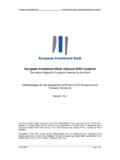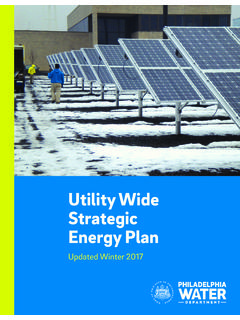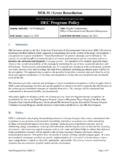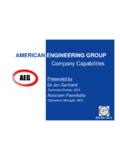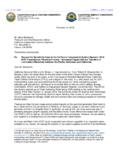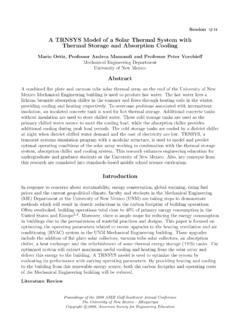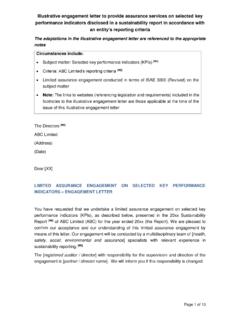Transcription of Are you Clear About Embedded Carbon and …
1 Are you Clear About Embedded Carbon and product Carbon FootprintsAre you Clear About Carbon - Information Sheet 7 | November 2012 1 Embedded Carbon : Embedded Carbon is a generic term used to describe the range of greenhouse gas (GHG) emissions associated with the production of a development of a product Carbon footprint provides an opportunity to understand in detail the Embedded Carbon of a product and in particular the stages of the product lifecycle that cause the most GHG Carbon footprint :A product Carbon footprint measures the GHG emissions at each stage of a product s life and includes: Extraction, production and transportation of raw materials, Processing of raw materials, Manufacture or service provision, assembly and packaging, Distribution (transport, storage and handling), Consumer use, End of life treatment and disposal of a each stage GHG emissions can result from sources such as energy use, transportation fuel, refrigerant losses from air conditioning units and waste treatment and you Clear About Carbon - Information Sheet 7 | November 2012 product Carbon footprints - considering the product life cycle stages:Activities to be considered when identifying relevant Carbon emissions:Raw Materials Includes all inputs used at any stage in the life cycle.
2 Includes processes related to raw materials such as mining/extraction, farming, forestry, pre-processing, packaging, storage and transport. Accounts for the impact of raw materials such as fertilisers (in their production, transport and application) and land use Includes all activities from the collection of raw materials to distribution such as production processes, transport/storage, packaging and site- related emissions such as lighting, ventilation and temperature. All materials produced need to be accounted for including the product , waste, co-products (useful by-products) and direct Includes all steps in transport and related storage, retail storage and display and temperature controlled storageConsumer Use Includes energy required during the use phase such as storage, preparation, application and Includes all steps in disposal such as transport, storage and processing.
3 Also includes energy required in the disposal/recycling process, and direct emissions due to disposal/recycling such as Carbon decay, methane release and MaterialsManufactureDistribution/ retailConsumer UseDisposal/recycling3 Are you Clear About Carbon - Information Sheet 7 | November 2012 Life Cyle Assessment - PAS 2050:PAS 2050 takes a process life cycle assessment (LCA) approach to evaluating the GHG emissions associated with goods or services, enabling companies to identify ways to minimise emissions across the entire product system. PAS 2050 follows 5 core principles: Relevance Select sources, data and methods appropriate to assessing the chosen product s life cycle GHG Include all GHG emissions that provide a material contribution to a product s life cycle emissions (including storage).
4 Consistency Enable meaningful comparisons in GHG-related Reduce bias and uncertainty as much as is practically When communicating, disclose enough information to allow third parties to make decisions with PAS 2050 methodology is also used to determine the Carbon footprint of products which receive the Carbon Trust a product Carbon footprint using the PAS 2050 methodology consists of 5 basic steps. All steps must be completed to achieve a footprint . Step 1 requires the development of a process map of the product s life cycle, from raw materials to disposal, including all material, energy and waste producing a process map, the following issues need to be considered: All raw materials should be taken into account.
5 Inputs and outputs, waste processes and transport must be considered for each stage, Different methodologies of customer use, In many cases recycling should be considered alongside types of process map can be developed which include the business to consumer model and the business to business Business to Consumer model involves taking into account the entire lifecycle of the product in question. This will include the consumer s use of the product and any disposal that is required. The Business to Business model involves measuring the Carbon from source to the stage at which the product is distributed to the customer. This method may prove more viable for complex items and allow for a chain of Business to Business models to be 1 RAw mATeRiAlsmAnufACTuReDisTRiBuTion / ReTAilConsumeR useDisposAl / ReCyClinGRAw mATeRiAlsmAnufACTuReDisTRiBuTion To A Business CusTomeRStep 4 involves the calculation of the product Carbon footprint .
6 GHG emissions factors are used with the collated data to calculate the Carbon emissions at each stage of the process map. These emissions figures can then be added together to produce an overall Carbon footprint for the review of the calculations is required to ensure that the proportions of emissions from different stages of the process map are in line with expectations and, where available, comparable product 5 requires an assessment of the accuracy of the footprint analysis. The objective of this step is to identify any areas of uncertainty in the footprint and the extent of that uncertaintyWhere uncertainty exists efforts should be made to reduce this. Where this is not possible, the nature and extent of any uncertainty should be explained in any footprint report.
7 This stage is important because it: Enables greater confidence in comparisons between products and in decision making, Identifies where to focus data collection efforts, Contributes to better understanding of the footprinting model itself (how it works, how to improve it and when it is robust enough), Indicates how reliable the footprint is for internal and external users of the 5 is vital to transparency, one of the fundamental principles of a PAS 2050 you Clear About Carbon - Information Sheet 7 | November 2012 Step 2 requires the confirmation of boundaries and the development of a high-level footprint calculation to help prioritise efforts. Without appropriate and consistent boundaries, it is difficult to make meaningful comparisons between products.
8 The key principle for setting system boundaries is to include the most significant emissions. Following this process, it may be necessary to re-visit step 1. Step 3 requires the collection of data on material amounts, activities and emissions factors across all life cycle collection can be the most challenging part of establishing a robust product Carbon footprint . Availability of data from organisations in the supply chain may be limited depending on the relationship with them and the level of influence that can be exerted. The best data to use is primary data collected from actual operations, however this may not be available for all aspects or stages and therefore it is acceptable to utilise secondary data which has been collected in similar situations.
9 Step 3 Step 4 Step 5 Step 25 Are you Clear About Carbon - Information Sheet 7 | November 2012 Using product Carbon FootprintsProduct Carbon footprints can be used in a number of different ways by process and product improvement Identifying Carbon hotspots enables organisations to identify which parts of their processes are most Carbon intensive and present the greatest opportunity for improvement. This is also known as hot-spotting .Hot-spotting can inform emissions reduction activity, which may be achieved through reducing the materials and energy used in production, substituting materials for ones with less Embedded Carbon , improving the energy efficiency of the product in use, reducing transport and packaging requirements, or making the product easier to remanufacture or of organisations that have used product Carbon footprints to inform process and product improvement can be found on page product related emissions over time If seeking to track reductions of GHG emissions associated with a product over time it is necessary to establish the Carbon footprint of the product at the outset.
10 This initial Carbon footprint is often referred to as a baseline Carbon footprint against which future Carbon footprinting exercises can be comparedIn tracking emissions over time it is important to understand the boundaries that have been applied to the initial baseline study and to try and ensure that these are consistent for future Carbon footprinting exercises. In addition some consideration should also be given to the uncertainties surrounding the data. It is likely that some data will become more accurate as experience and understanding of the data measurement and collection processes a recalculation of the initial baseline Carbon footprint may be necessary if improvements in data accuracy significantly affect Carbon footprints to compare products One of the main long term aims of using product footprints is to be able to compare one product against another.
